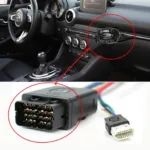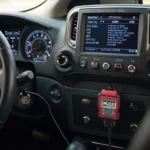Understanding your car’s transmission is crucial for optimal performance and longevity. Accessing transmission info through OBD2 offers a powerful way to diagnose issues, monitor performance, and ensure smooth shifting. This article delves into the world of OBD2 and its role in unlocking the secrets of your vehicle’s transmission. We’ll explore how OBD2 scanners work, the types of transmission data they can retrieve, and how you can use this information for preventative maintenance and troubleshooting. what does the obd2 connect to
How OBD2 Unlocks Transmission Secrets
OBD2, or On-Board Diagnostics 2, is a standardized system that allows you to access your vehicle’s diagnostic data. It acts as a window into the inner workings of various systems, including the transmission. By connecting an OBD2 scanner to your car’s diagnostic port, you can retrieve valuable data about transmission performance, identify potential problems, and even monitor real-time parameters.
 OBD2 Scanner Connected to a Car's Diagnostic Port
OBD2 Scanner Connected to a Car's Diagnostic Port
Types of Transmission Data Available via OBD2
OBD2 scanners can access a wide range of transmission-related data, including:
- Transmission fluid temperature: Overheating transmission fluid can lead to serious damage. Monitoring this parameter allows you to identify potential problems before they escalate.
- Shift solenoids: These components control the flow of transmission fluid, enabling gear changes. OBD2 can detect malfunctions in these solenoids.
- Torque converter clutch: The torque converter clutch improves fuel efficiency by locking the engine and transmission together at higher speeds. OBD2 can detect slippage or other issues with this clutch.
- Gear ratios: Monitoring gear ratios can help diagnose problems with shifting or incorrect gear selection.
- Input and output shaft speeds: Differences between these speeds can indicate internal transmission problems.
Using Transmission Info for Preventative Maintenance
Regularly monitoring your transmission data via OBD2 allows you to perform preventative maintenance and potentially avoid costly repairs. For example, consistently high transmission fluid temperatures could indicate a need for a fluid change or a problem with the transmission cooler. By addressing these issues early, you can prevent further damage and extend the life of your transmission.
Troubleshooting Transmission Problems with OBD2
When you experience transmission problems, an OBD2 scanner can be invaluable in diagnosing the cause. The trouble codes retrieved by the scanner pinpoint specific areas to investigate, saving you time and money on unnecessary repairs. For instance, a code related to a specific shift solenoid can quickly narrow down the problem.
What does OBD2 tell you about a transmission?
OBD2 can provide a wealth of information about your transmission, from fluid temperature and pressure to shift solenoid status and gear ratios. This information can be crucial for diagnosing and preventing transmission problems.
Can an OBD2 scanner read transmission temperature?
Yes, many OBD2 scanners can read transmission fluid temperature, a crucial parameter for monitoring transmission health.
What information can I get from my car’s OBD2 port?
The OBD2 port provides access to a wealth of information about your car’s various systems, including the engine, transmission, emissions system, and more.
Is there a generic OBD2 scanner?
Yes, there are obd2 generic scan tool available that can read basic diagnostic trouble codes from most vehicles.
“Using OBD2 to monitor transmission data is like having a doctor constantly checking your car’s vital signs. It allows you to catch potential problems early and prevent major issues down the line.” – John Smith, Automotive Engineer
“OBD2 scanners are essential tools for any car owner who wants to understand and maintain their vehicle’s transmission. They empower you to take control of your car’s health and avoid costly surprises.” – Jane Doe, Certified Mechanic
Accessing transmission info through OBD2 offers a powerful way to understand and maintain your vehicle’s transmission. By leveraging the data available through the OBD2 port, you can proactively address potential problems, extend the life of your transmission, and enjoy a smoother, more reliable driving experience. obd2 取得 情報
FAQ
-
What is OBD2?
OBD2 is a standardized system for accessing vehicle diagnostic data. -
How can I access transmission info through OBD2?
By connecting an OBD2 scanner to your car’s diagnostic port. -
What types of transmission data are available?
Fluid temperature, shift solenoid status, torque converter clutch status, gear ratios, and more. -
How can I use this information?
For preventative maintenance and troubleshooting transmission problems. -
What are the benefits of using OBD2 for transmission maintenance?
Early problem detection, cost savings, and improved vehicle reliability. -
Can any OBD2 scanner read transmission data?
Many scanners can, but some may have limited capabilities. -
Where can I find more information about OBD2?
OBDFree.com provides extensive resources on OBD2 scanners and their uses.
Need help with your car diagnostics? Contact us via WhatsApp: +1(641)206-8880, Email: [email protected] or visit us at 789 Elm Street, San Francisco, CA 94102, USA. Our customer support team is available 24/7.

